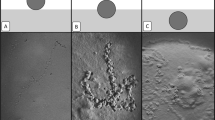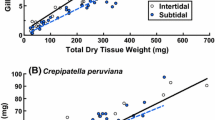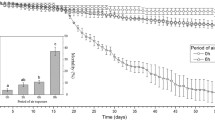Abstract
Physiological responses of two bivalves (Mytilus edulis L. and Cardium edule L.) to intertidal conditions were studied. Specimens were collected from S. W. England in autumn/winter, 1980, and acclimatized to either intertidal or subtidal regimes before measurement of rates of heat dissipation \(\left( {{}_t\dot q} \right)\) and oxygen uptake \(\left( {\dot \upsilon _{{\rm O}_2 } } \right)\) during 5 h of air exposure, and rates of \(\dot \upsilon _{{\rm O}_2 }\), particle clearance, ammonia excretion, and food-absorption efficiency during 7 h of reimmersion. Subtidal individuals were either intermittently or continuously fed in order to distinguish the effects of periodic food supply from the effects of air exposure. Specimens of M. edulis had low aerial rates of \({}_t\dot q\) (14 to 20% of aquatic rate), and \({}_t\dot q\) was greater than the energy equivalent of \(\dot \upsilon _{{\rm O}_2 }\), indicating that they were largely anaerobic. In contrast, C. edule “air-gaped” and had higher aerial rates of \({}_t\dot q\) and \(\dot \upsilon _{{\rm O}_2 }\) (50 to 75% of aquatic rate). There were behavioural and metabolic differences in the responses of intertidally and subtidally acclimatized mussels and cockles to air exposure. Intertidal individuals of both species were more quiescent, had lower aerial rates of \({}_t\dot q\) and \(\dot \upsilon _{{\rm O}_2 }\), and showed a conditioned response at the “expected” time of reimmersion. The reduction in aerial rate of \({}_t\dot q\) was an energy-saving mechanism and the payment of the “oxygen-debt” within 2 h of reimmersion represented a significant “cost”. The “heat increment” associated with feeding and digestion was estimated as 15 to 17% of the oxygen uptake by M. edulis during all stages of recovery. M. edulis adapted to the intertidal regime by reducing its time-averaged aerial and aquatic rates of ammonia excretion. In contrast, C. edule maintained a high aerial and aquatic rate of ammonia excretion. The clearance rates of M. edulis recovered rapidly (0.5 to 1.5 h) following reimmersion, whereas those of C. edule recovered more slowly, particularly for the subtidal individuals following acute exposure (>4 h). There was no evidence of increased clearance rate or absorption efficiency by intertidal individuals to compensate for the loss of feeding time. Intertidally acclimatized individuals of M. edulis and C. edule had more energy available for growth (scope for growth) integrated over a 12 h period and higher growth efficiencies than subtidal individuals subjected to acute air exposure and intermittent feeding regimes. This was the result of reduced aerial and aquatic rates of energy expenditure, a relatively small “cost” in terms of the payment of “oxygen-debt” and a rapid recovery of clearance rate following reimmersion.
Similar content being viewed by others
Literature cited
Bayne, B. L., C. J. Bayne, T. C. Carefoot and R. J. Thompson: The physiological ecology of Mytilus californianus (Conrad) 2. Adaptations to low oxygen tension and air exposure. Oecologia 22, 229–250 (1976a)
Bayne, B. L. and D. R. Livingstone: Responses of Mytilus edulis L. to low oxygen tension: acclimation of the rate of oxygen consumption. J. comp. Physiol. 114B, 129–142 (1977)
Bayne, B. L. and C. Scullard: Rates of nitrogen excretion by species of Mytilus (Bivalvia: Mollusca). J. mar. biol. Ass. U.K. 57, 355–369 (1977a)
Bayne, B. L. and C. Scullard: An apparent specific dynamic action in Mytilus edulis L. J. mar. biol. Ass. U.K. 57, 371–378 (1977b)
Bayne, B. L., R. J. Thompson and J. Widdows: Physiology I. In: Marine mussels: their ecology and physiology, pp 121–206. Ed. by B. L. Bayne. Cambridge: Cambridge University Press 1976b
Boyden, C. R.: The behaviour, survival and respiration of the cockles Cerastoderma edulis and C. glaucum in air. J. mar. biol. Ass. U.K. 52, 661–680 (1972)
Brett, J. R. and T. D. D. Groves: Physiological energetics. In: Fish physiology. Vol. VIII. Bioenergetics and growth, pp 279–342. Ed. by W. S. Hoar, D. J. Randall and J. R. Brett. New York: Academic Press 1979
Brinkhoff, W., K. Stockmann and M. Grieshaber: Natural occurrence of anaerobiosis in molluscs from intertidal habitats. Oecologia 57, 151–155 (1983)
Conover, R. J.: Assimilation of organic matter by zooplankton. Limnol. Oceanogr. 11, 338–354 (1966)
Famme, P., J. Knudsen and E. S. Hansen: The effect of oxygen on the aerobic-anaerobic metabolism of the marine bivalve, Mytilus edulis L. Mar. Biol. Lett. 2, 345–351 (1981)
Gäde, G.: Anaerobic metabolism of the common cockle, Cardium edule. Archs int. Physiol. Biochim. 83, 879–886 (1975)
Gillmor, R. B.: Assessment of intertidal growth and capacity adaptations in suspension-feeding bivalves. Mar. Biol. 68, 277–286 (1982)
Gnaiger, E.: The twin-flow microrespirometer and simultaneous calorimetry. In: Polarographic oxygen sensors: aquatic and physiological applications, pp 134–166. Ed. by E. Gnaiger and H. Forstner. Berlin: Springer-Verlag 1983a
Gnaiger, E.: Heat dissipation and energetic efficiency in animal anoxibiosis. J. exp. Zool. 228, 471–490 (1983b)
Gnaiger, E., J. M. Shick and J. Widdows: A metabolic interpretation of direct calorimetry and oxygen uptake: the anaerobicaerobic transition in Mytilus edulis. (In preparation)
Gordon, J. and M. R. Carriker: Sclerotized protein in the shell matrix of a bivalve mollusc. Mar. Biol. 57, 251–260 (1980)
Griffiths, R. R.: Aerial exposure and energy balance in littoral and sublittoral Choromytilus meridionalis (Kr). (Bivalvia). J. exp. mar. Biol. Ecol. 52, 231–241 (1981)
Griffiths, R. J. and R. Buffenstein: Aerial exposure and energy input in the bivalve Choromytilus meridionalis (Kr). J. exp. mar. Biol. Ecol. 52, 219–229 (1981)
Hawkins, A. J. S., P. N. Salkeld, B. L. Bayne, E. Gnaiger and D. M. Lowe: Resource acquisition and allocation in Mytilus edulis: evidence for time-average optimisation. Mar. Ecol. Prog. Ser. 20, 273–287 (1985)
Johnstone, J.: Cardium. L.M.B.C. Mem. typ. Br. mar. Pl. Anim. 2, 1–84 (1899)
Jordon, T. E. and I. Valiela: A nitrogen budget of the ribbed mussel, Geukensia demissa, and its significance in nitrogen flow in a New England salt marsh. Limnol. Oceanogr. 27, 75–90 (1982)
Keunzler, E. J.: Structure and energy flow of a mussel population in a Georgia salt marsh. Limnol. Oceanogr. 6, 191–204 (1961)
Lent, C. M.: Air gaping by the ribbed mussel, Modiolus demissus (Dillwyn). Effects and adaptive significance. Biol. Bull. mar. biol. Lab., Woods Hole 134, 60–73 (1968)
Livingstone, D. R. and B. L. Bayne: Responses of Mytilus edulis L. to low oxygen tension: anaerobic metabolism of the posterior adductor muscle and mantle tissues. J. comp. Physiol. 114, 143–155 (1977)
Lowe, D. M., M. N. Moore and B. L. Bayne: Aspects of gametogenesis in the marine mussel, Mytilus edulis L. J. mar. biol. Ass. U.K. 62, 133–145 (1982)
Meinardus, G. and G. Gäde: Anaerobic metabolism of the common cockle, Cardium edule. IV. Time dependent changes of metabolites in the foot and gill tissue induced by anoxia and electrical stimulation. Comp. Biochem. Physiol. 70b, 271–277 (1981)
Newell, R. I. E.: The eco-physiology of Cardium edule (Linné), 215 pp. Ph.D. thesis, University of London 1977
Newell, R. I. E. and B. L. Bayne: Seasonal changes in the physiology, reproductive condition and carbohydrate content of the cockle Cardium (=Cerastoderma) edule (Bivalvia: Cardiidae). Mar. Biol. 56, 11–19 (1980)
Nicchitta, C. V. and W. R. Ellington. Energy metabolism during air exposure and recovery in the high intertidal bivalve mollusc Geukensia demissa granosissima and the subtidal bivalve mollusc Modiolus squamosus. Biol. Bull. mar. biol. Lab., Woods Hole 165, 708–722 (1983)
Pamatmat, M. M.: Facultative anaerobiosis of benthos. In: Marine benthic dynamics, pp 69–90. Ed. by K. R. Tenore and B. C. Coull. Columbia University of South Carolina 1980
Pamatmat, M. M.: Simultaneous direct and indirect calorimetry. In: Polarographic oxygen sensors: aquatic and physiological applications. pp 167–175. Ed. by E. Gnaiger and H. Forstner. Berlin: Springer-Verlag 1983
Prampero, P. E., di: Energetics of muscular exercise. Rev. Physiol. Biochem. Pharmacol. 89, 143–222 (1981)
Shick, J. M.: Heat production and oxygen uptake in intertidal sea anemones from different shore heights during exposure to air. Mar. Biol. Lett. 2, 225–236 (1981)
Shick, J. M., E. Gnaiger, J. Widdows and B. L. Bayne: Metabolism and activity in the mussel Mytilus edulis L. during recovery from intertidal exposure. (In preparation)
Shick, J. M. and J. Widdows: Direct and indirect calorimetric measurement of metabolic rate in bivalve molluscs during aerial exposure. Am. Zool. 21, p. 983 (1981)
Shick, J. M., A. de Zwaan and A. M. T. de Bont: Anoxic metabolic rate in the mussel Mytilus edulis L. estimated by simultaneous direct calorimetry and biochemical analysis. Physiol. Zoöl. 56, 56–63 (1983)
Spencer-Davies, P.: A constant pressure respirometer for medium sized animals. Oikos 17, 108–112 (1966)
Solórzano, L.: Determination of ammonia in natural waters by the phenolhypochlorite method. Limnol. Oceanogr. 14, 799–801 (1969)
Vooys, C. G. N., de and A. de Zwaan: The rates of oxygen consumption and ammonia excretion by Mytilus edulis after various periods of exposure to air. Comp. Biochem. Physiol. 60, 343–347 (1978)
Waarde, A., van: Aerobic and anaerobic ammonia production by fish. Comp. Biochem. Physiol. 74B, 675–684 (1983)
Waite, J. H.: Quinone-tanned scleroproteins. In: The Mollusca. Vol. 1. Metabolic biochemistry and molecular mechanics, pp 467–504. Ed. by P. W. Hochachka. New York: Academic Press 1983
Waite, J. H. and S. O. Andersen: 3,4-dihydroxyphenylalanine (Dopa) and sclerotization of periostracum in Mytilus edulis L. Biol. Bull. mar. biol. Lab., Woods Hole 158, 164–173 (1980)
Warren, C. E. and G. E. Davis: Laboratory studies on the feeding, bioenergetics and growth of fish. In: The biological basis of freshwater fish production, pp 175–214. Ed. by S. D. Gerking. Oxford: Blackwell Scientific Publications 1967
Widdows, J.: Combined effects of body size, food concentration and season on the physiology of Mytilus edulis. J. mar. biol. Ass. U.K. 58, 109–124 (1978)
Widdows, J.: Physiological procedures. In: The effects of stress and pollution on marine animals, Ed. by B. L. Bayne et al. New York: Praeger Press 1985
Widdows, J., B. L. Bayne, D. R. Livingstone, R. I. E. Newell and P. Donkin: Physiological and biochemical responses of bivalve molluscs to exposure to air. Comp. Biochem. Physiol. 62A, 301–308 (1979)
Winberg, G. G.: Rate of metabolism and food requirements of fishes. Transl. Ser. Fish. Res. Bd Can. 194, 1–202 (1960)
Zar, J. H.: Biostatistical analysis, 620 pp New Jersey: Prentice-Hall 1974
Zwaan, A., de.: Anaerobic energy metabolism in bivalve molluscs. Oceanogr. mar. Biol. A. Rev. 15, 103–187 (1977)
Zwaan, A. de., A. M. T. de Bont, W. Zurburg, B. L. Bayne and D. R. Livingstone: On the role of strombine formation in the energy metabolism of adductor muscle of a sessile bivalve. J. comp. Physiol. 149, 557–563 (1983)
Author information
Authors and Affiliations
Additional information
Communicated by J. Mauchline, Oban
Rights and permissions
About this article
Cite this article
Widdows, J., Shick, J.M. Physiological responses of Mytilus edulis and Cardium edule to aerial exposure. Marine Biology 85, 217–232 (1985). https://doi.org/10.1007/BF00393242
Accepted:
Issue Date:
DOI: https://doi.org/10.1007/BF00393242




